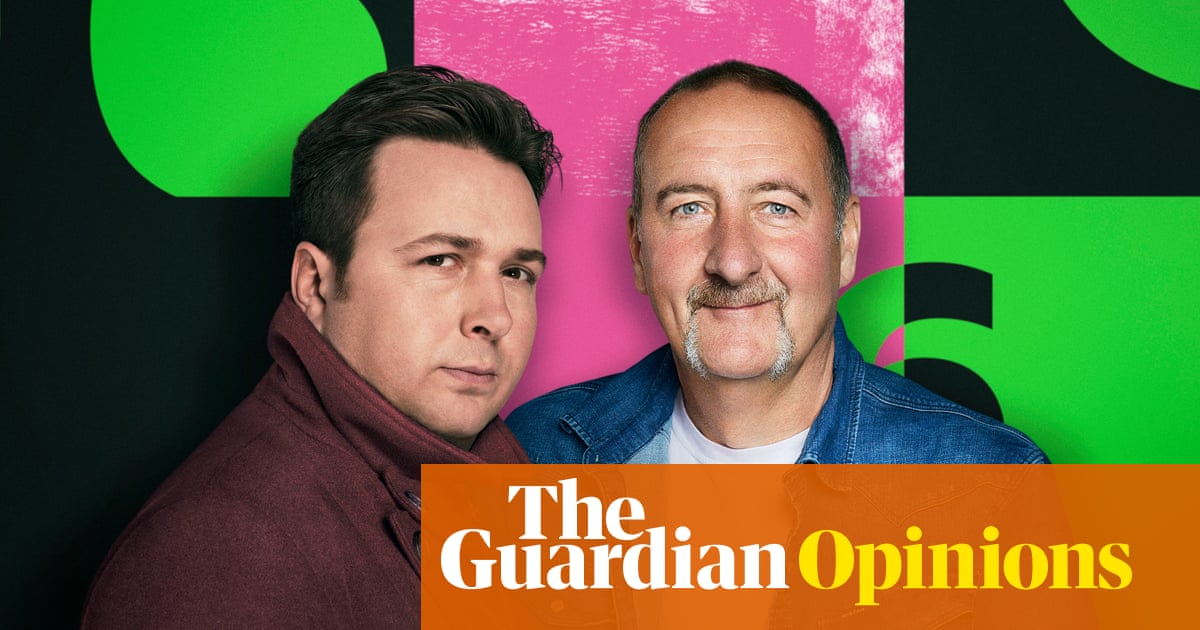
‘The fashion event of the year is here,” announced pop artist Self Esteem in March, of a new addition to her merch store. “The 6 Music Dad caps are now available.” The 6 Music Dad character – referring to the BBC radio station – is part harmless joke, part slur. Broadly speaking, it’s aimed at people who had their formative musical years somewhere between the late 1970s and early 90s, ducked out of following music passionately while work and family life took over, and now with grownup kids, and some disposable cash to burn, dad is getting back into vinyl, lacing up the Converse and busting out the ergonomic lawn chair for festival season.
6 Music is a one-stop-shop for alternative music if you’ve no desire, or time, to search further afield. So breakthrough bands on the station – such as Wet Leg, Yard Act, and even Self Esteem – often attract a healthy following of these re-energised dads. It’s generally lighthearted ribbing, and the Self Esteem merch feels more endearing nod than cruel swipe – there is also a “6 Music Daddy” cap – but they are also often described in mocking caricatures: as balding, ale-drinking blokes solemnly nodding alongside bouncing kids.
It’s the “OK boomer” of the indie music world; a flippant and generalising piss-take that doesn’t possess much weight or sting but carries an undercurrent of ageism, and characterises its target as culturally shallow. But teased and uncool as they may be, the 6 Music Dads are also gobbling up gig tickets, records and merch – they are a vital part of music’s ecosystem.
Maybe 6 Music has taken this jibe to heart. There has been an undeniable culture shift at the station, which feels as if it’s trying to shake that vibe (the current network strategy is aimed at growing audiences aged between 25 and 44). There have been numerous reshuffles: Marc Riley and Gideon Coe both lost longstanding individual shows this year, instead merging for a new, later, one. In came Tom Ravenscroft and Deb Grant’s New Music Fix show alongside the Artist in Residence series. People grumbled and petitions were made. Stewart Lee mourned their loss in the Observer: “Those evening session shows shaped a generation of tastes.”
The shake-up is understandable: Monday-Thursday 4pm-midnight consisted solely of three white blokes in their 50s and 60s – Steve Lamacq, Riley, Coe – playing guitar music. Although given Riley has been a tireless champion and breaker of young new bands, offering primetime spots for live sessions, it feels a strange, almost disingenuous, move to demote him to prioritise new music.
Grant and Ravenscroft’s new show is genuinely excellent, however, offering up a punchy and eclectic mix of genre-spanning music, from a label focus on PC Music to spotlighting local DIY scenes, such as Sheffield’s queer collective Gut Level. Similarly, Jamz Supernova getting more air time and the long overdue departure of Liz Kershaw are both welcome moves.
But despite all this shuffling and targeting of younger listeners, it all feels fundamentally at odds with the tiring cycle of themed days: Rave Forever, All Day Rave, 6 Music Goes Back to the 80s, 90s, 00s, 10s etc. For a radio station with almost zero history of specialising in dance music – with the exception of a handful of DJs, such as Nemone, Mary Anne Hobbs or more recent additions such as the Blessed Madonna – it seems odd that it’s now trying to position itself as a mecca for rave. Even more so that it’s opting to do it via such a coerced and weak format.
The bulk of the 6 Music presenters are simply not ex-ravers, so the shows often don’t land. On a recent Craig Charles show, with Chris Hawkins sitting in during the 80s Rave Forever day, you heard slamming club anthems by Joy Division, Elvis Costello and, er, Rush. Filling in for Lauren Laverne on Rave Forever 90s, Huw Stephens blasted ATB’s 9pm (Til I Come) and Darude’s Sandstorm. It may well be that Stephens is a diehard superclub-era trance fan but given his respected reputation – he replaced John Peel on Radio 1 in 2005 – of championing new, underground artists, his talents feel wasted with such a restrictive and narrow mandate.
When radio veterans Mark Radcliffe and Stuart Maconie, who have shows covering folk and avant garde on Radio 2 and 6, are told to play all day rave, who exactly is this for? How do they as presenters, their audience, or the station, benefit? Audiences and DJs have open minds and broad tastes – and eclecticism and experimentation is needed – but surely the presenters are capable of steering this without imposing ill-fitting, formulaic retro shows on them?
This conflict is reflected in the station’s playlist, too. There has been a notable shift away from its indie rock foundations, resulting in a much more interesting selection. But has expanding the remit resulted in it being so broad that it fails to fully satisfy anyone? The apparent resistance to being categorised as a 6 Music Dad station also feels extra muddled when you factor in things such as the recent eight-part 30th anniversary Britpop series – a subject so worn and threadbare surely even Lamacq has run out of things to say on it – or the Strokes’ Albert Hammond Jr playing 13 Guided By Voices tracks back-to-back in one Artist in Residence show.
In a way 6 Music has snookered itself. The station has built its name up on the reputation of DJs such as Riley, Lamacq, Coe, Laverne, and the now-departed Shaun Keaveny, but failed to break enough new young talent or diverse voices along the way. So when old names synonymous with the station – who maybe don’t align with the current vision – get sidelined, it sparks backlash from loyal listeners who cry ageism. Then some of the newer shows and presenters can feel shoehorned in rather than the byproduct of nurtured talent.
This flitting between forced nostalgia and a determined focus on the new, while shaking off the still-beloved old, feels like an identity crisis; the corporation’s other radio stations each have a much better honed and more easily comprehensible vision – and thus a closer and more natural affinity with listeners. Bosses at 6 Music would probably argue that its strength is in its unpredictability and genre fluidity. But it feels as if the station doesn’t know what it is or wants to be – or who it wants as its audience. One minute it’s aiming for hip NTS territory and the next it’s Radio 2 for acid house retirees, all while losing the core essence of what made it the most popular digital radio station in the country in the first place.
The ultimate irony is that perhaps in trying to escape the desperately uncool 6 Music Dad image attached to the station, it has sunk itself into its own midlife crisis.












